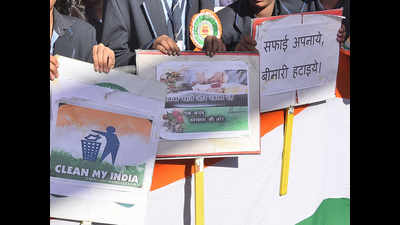- News
- City News
- mysuru News
- University of Mysuru students document Mysuru’s tryst with cleanliness
Trending
This story is from January 23, 2017
University of Mysuru students document Mysuru’s tryst with cleanliness
A documentary that chronicles the 100-year journey of Mysuru city to become India’s cleanest city is all set to be screened at a national-level competition organized by Vigyan Prasar, Union ministry of science and technology, in Kolkata in February second week.

Representative image
Mysuru: A documentary that chronicles the 100-year journey of Mysuru city to become India’s cleanest city is all set to be screened at a national-level competition organized by Vigyan Prasar, Union ministry of science and technology, in Kolkata in February second week.
The fact that the royal city of Mysuru got the cleanest city tag among 476 cities across the country in 2015 inspired the students of University of Mysuru to explore how and why the city has got this title.Students Lakshmikanth Kaudale, Shivendra Urs and M Nanjundaswamy, Mahesh Hiremath, Santhosh Shikaripura and L Sagar have now come out with the 19-minute documentary.
Urs, who has directed the documentary, told TOI that the documentary makes an attempt to decipher how and when the conscious for cleanliness developed among Mysureans besides identifying the contribution of the Wadiyars, Nalwadi Krishnaraja Wadiyar in particularly, in this regard.
“The awareness about keeping the city clean started with the Wadiyars who developed the city in a planned manner. They laid 1,580km of underground drainage (UGD) network with 60,000 manholes a century ago, and it is still intact. This happens to be one of the reasons why open defecation is minimum in the city,’’ he added.
The fact that the royal city of Mysuru got the cleanest city tag among 476 cities across the country in 2015 inspired the students of University of Mysuru to explore how and why the city has got this title.Students Lakshmikanth Kaudale, Shivendra Urs and M Nanjundaswamy, Mahesh Hiremath, Santhosh Shikaripura and L Sagar have now come out with the 19-minute documentary.
Urs, who has directed the documentary, told TOI that the documentary makes an attempt to decipher how and when the conscious for cleanliness developed among Mysureans besides identifying the contribution of the Wadiyars, Nalwadi Krishnaraja Wadiyar in particularly, in this regard.
“The awareness about keeping the city clean started with the Wadiyars who developed the city in a planned manner. They laid 1,580km of underground drainage (UGD) network with 60,000 manholes a century ago, and it is still intact. This happens to be one of the reasons why open defecation is minimum in the city,’’ he added.
The documentary also shows how waste is being managed by Mysuru City Corporation through its various initiatives to keep the city clean. The role and contribution of pourakarmikas, who are cleanliness soldiers in the real sense, in getting the cleanest city tag has also been highlighted, he added.
End of Article
FOLLOW US ON SOCIAL MEDIA










